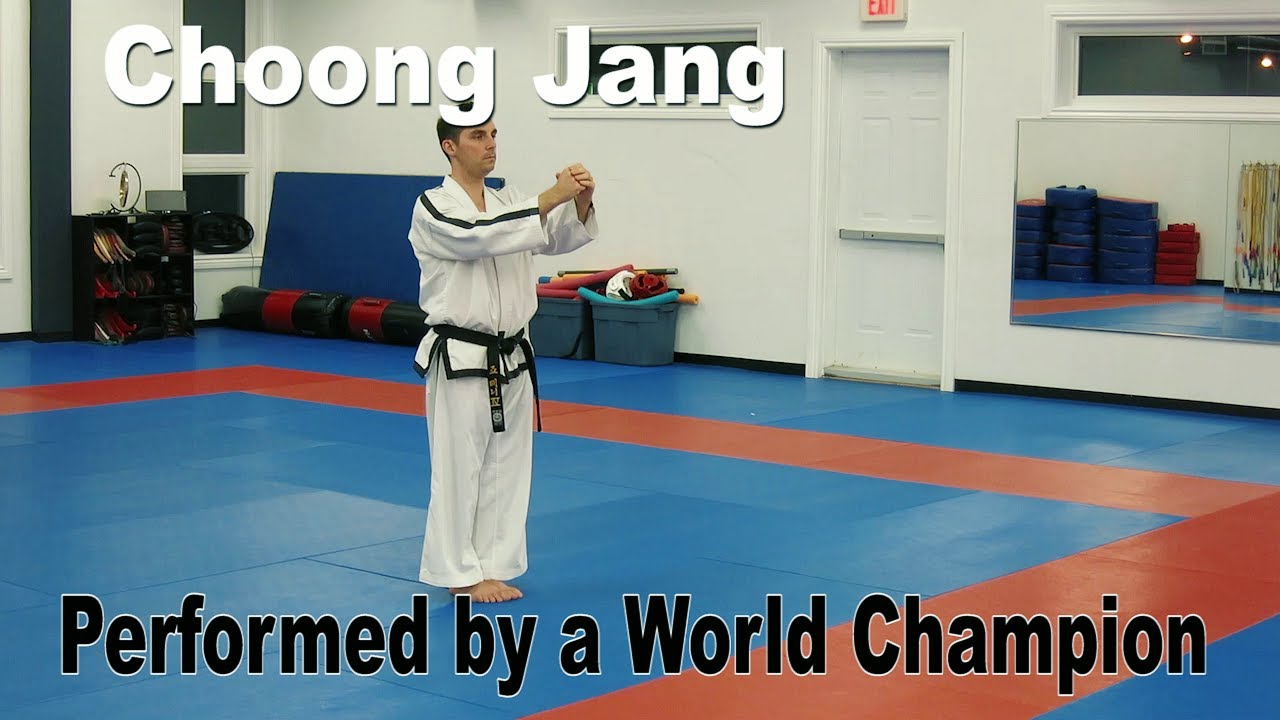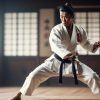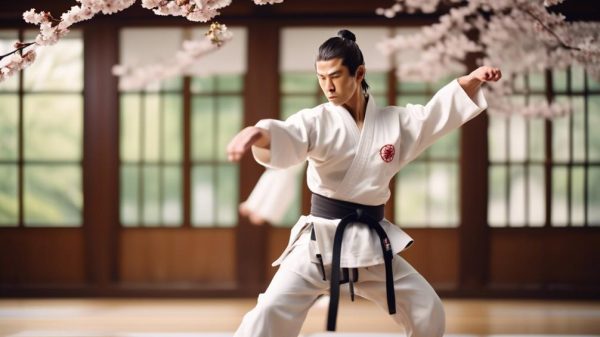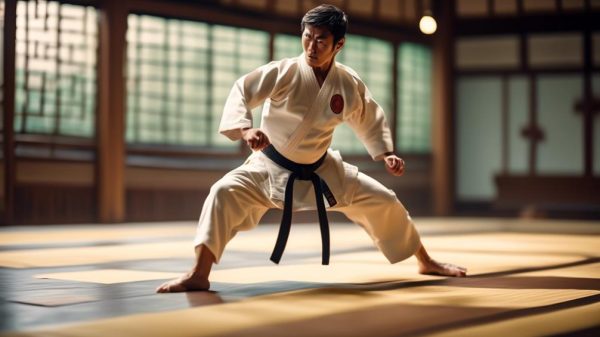Let’s dive into the intricacies of Form Choong Jang. This form holds great significance, as it not only focuses on the physical movements but also delves into the philosophy of martial arts and the development of one’s character.
By studying the details of Choong-Jang Form, you will uncover the timeless principles that have been passed down through generations of martial artists. Understanding the background, key movements, and practical applications of this form will not only improve your technical skills but also provide a deeper understanding of the holistic nature of martial arts practice.
Key Takeaways
- Choong-Jang has 36 movements and was named after a great 15th century Korean general renowned for his martial skills. Understanding the history enriches training this form.
- Proper breathing, tension, and relaxation are crucial in executing Choong-Jang techniques like powerful vertical punches and knifehand strikes. Mastering control is key.
- The form builds endurance with its extensive footwork, direction changes, and lunging motions. Moving through the entire sequence develops stamina.
- Speed and rhythm are essential in Choong-Jang. Quickly accelerating then coming to an abrupt stop exemplifies an important Taekwondo principle.
- Offensive techniques like front kicks and knifehand strikes train quick reactive defense through blocks and parries in between. Choong-Jang trains rapid transitions between attack and defense.
- Precision is critical in the symmetry and lines of motion in the form. Attention to detail in stance, foot pivoting, and technique angles develops control.
Background of Choong Jang Form
The background of Choong Jang Form in Taekwondo America is rooted in its rich history and cultural significance. This form holds a special place in ITF-style Taekwondo and is specifically designed for 2nd-degree black belt practitioners.
Mastering Choong Jang is crucial for progression within Taekwondo America as it serves as a testament to dedication, discipline, and skill. It goes beyond learning a series of movements; it immerses practitioners in the essence of martial arts. Choong Jang embodies the principles of balance, power, and grace, challenging practitioners to merge physical strength with mental focus.
Key Movements & Techniques
As you explore the intricate art of Taekwondo America Form Choong Jang, you’ll encounter a precise and deliberate sequence of key movements and techniques that require unwavering focus and dedication. Mastering these key movements and techniques is crucial for advancing to the 2nd-degree black belt level and demonstrates your progress in Taekwondo America.
Here are four important aspects to consider as you strive for mastery:
- Precision & Control: Each block, strike, kick, and stance in Form Choong Jang must be executed with meticulous precision and unwavering control, showcasing your dedication to the art.
- Physical & Mental Development: Practicing Form Choong Jang challenges your physical strength, flexibility, mental focus, concentration, and self-confidence, contributing to your overall development.
- Integration of Skills: Mastery of this form integrates the knowledge and techniques acquired from previous forms, reflecting your continuous growth and improvement as a practitioner.
- Demonstration of Progress: Mastering Form Choong Jang is a testament to your ability to perform complex techniques with precision, highlighting your dedication and progress within Taekwondo America.
Embrace the challenges presented by Form Choong Jang as opportunities for growth, refinement, and advancement in your martial arts journey.
Common Mistakes to Avoid
Make sure to avoid rushing through the movements of Form Choong-Jang, as sacrificing precision and technique can hinder your progress in mastering this intricate form. Take the time to execute each movement with focused attention to detail.
Neglecting stances and footwork can compromise the overall structure and effectiveness of the form. Emphasize the importance of maintaining proper stances and executing precise footwork to ensure the integrity of each technique.
Additionally, don’t underestimate the significance of synchronized breathing. Your breath should flow harmoniously with your movements, enhancing both control and balance.
Incomplete extension of techniques diminishes the power and impact of your actions. Each strike, block, and kick should be fully extended to convey strength and precision.
Lastly, don’t overlook the symbolism of the form’s ending. The final left-hand attack represents the tragic death of Kim Duk Ryang and holds deep meaning. Respect and embody this symbolism in the concluding movements of the form.
Mastering these nuances is crucial on the path to achieving black belt proficiency in Taekwondo forms.
Tips for Perfecting Your Form
Strive to enhance your execution of Form Choong-Jang by focusing on the precision and technique of each movement. This is crucial for mastering this intricate form. To perfect your form and demonstrate your expertise in Taekwondo America, consider the following tips:
- Mindful Practice: Approach each practice session with focus and mindfulness. Concentrate on the details of each movement, ensuring that your techniques are accurate and powerful.
- Seek Expert Guidance: Consult experienced instructors to receive valuable feedback on your performance. Their insights can help you identify areas for improvement and refine your execution.
- Utilize Resources: Take advantage of available resources such as video demonstrations and instructional materials. Studying these resources can provide additional clarity on the nuances of Form Choong-Jang.
- Embrace Perseverance: Understand that mastery of forms, including Choong-Jang, requires dedication and perseverance. Embrace the journey of continuous improvement and remain committed to achieving excellence.
Applications in Sparring & Self-Defense
Choong-Jang offers valuable techniques for both sparring and self-defense situations. By incorporating the precise and powerful movements of this form, practitioners can effectively counter opponents’ attacks with controlled and impactful defense.
In sparring, Choong-Jang’s blocking, striking, and kicking techniques can be adapted to defend against various types of attacks. The focus on precision allows practitioners to execute techniques accurately, while the emphasis on power enables them to deliver impactful defenses. This combination of precision and power is essential for responding to opponents’ movements with controlled and effective techniques.
In real-world self-defense scenarios, Choong-Jang’s combination of blocks, strikes, and kicks can be utilized to respond to different physical threats. By practicing this form, practitioners develop mental focus and concentration, which are crucial for anticipating and reacting to opponents’ actions.
Whether in sparring or self-defense, the principles of Choong-Jang empower practitioners to effectively defend themselves while maintaining control and precision in their techniques. Mastering Choong-Jang not only enhances physical prowess but also cultivates a resilient and strategic mindset in combat situations.
Frequently Asked Questions
What Is the Meaning of Choong Jang?
The meaning of Choong Jang represents the spirit of determination and perseverance in the practice of Taekwondo. It signifies the constant pursuit of balance and harmony, reflecting the rich history and philosophy of this martial art.
How Do You Memorize Taekwondo Forms?
To become proficient in Taekwondo forms, utilize memory techniques and visual cues to help you remember the sequence of movements. Develop muscle memory by regularly practicing drills. Embrace repetition and maintain focus on the task at hand. As you internalize the movements, the form will become a natural part of your skillset.
What Is a Recommended Black Belt?
A recommended black belt is a symbol of your progression in martial arts, indicating your dedication and discipline in training. It represents your mastery in recommended forms such as Choong-Jang, which is crucial for advancing and showcasing your skill level.
What Are Taekwondo Forms Called?
Taekwondo forms, also known as patterns or hyungs, play a vital role in belt progression and training. Mastering these forms is crucial for advancing in the art. They teach essential techniques and principles, and demonstrating proficiency in forms is key to moving forward.









